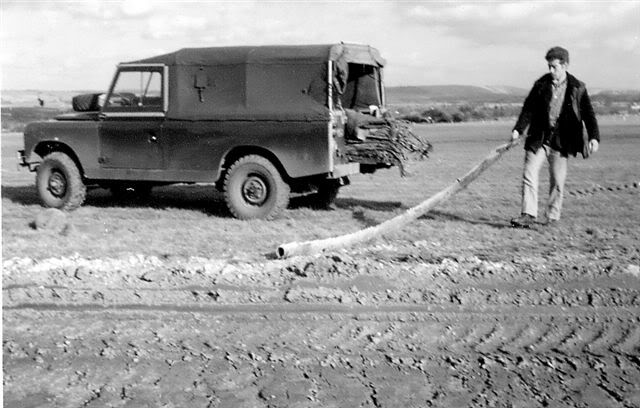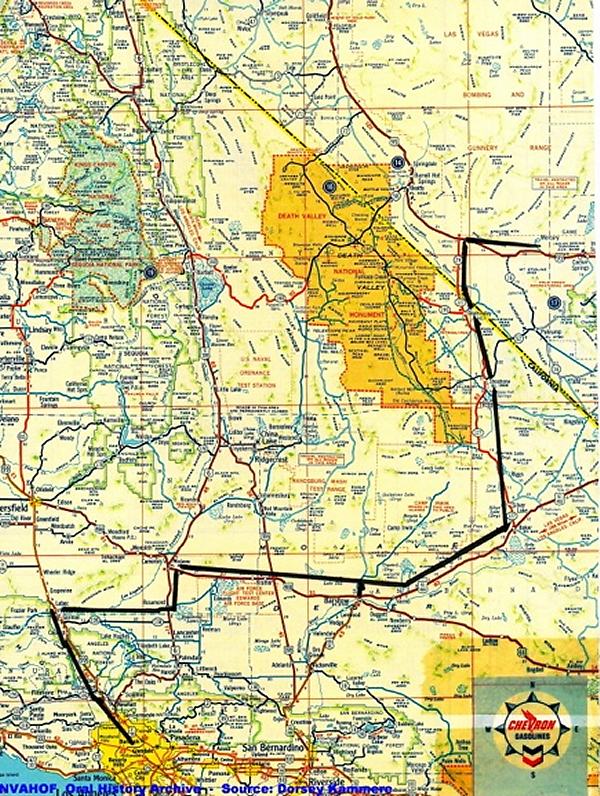Allied fighter-bombers continued to attack not only front-line positions, but also any supply trucks coming up behind with food, ammunition and fuel. The almost total absence of the Luftwaffe to contest the enemy’s air supremacy continued to provoke anger among German troops, although they often resorted to black humour. “If you can see silver aircraft, they are American,” went one joke. “If you can see khaki planes, they are British, and if you can’t see any planes, then they’re German.” The other version of this went, “If British planes appear, we duck. If American planes come over, everyone ducks. And if the Luftwaffe appears, nobody ducks.” American forces had a different problem. Their trigger-happy soldiers were always opening fire at aircraft despite orders not to because they were far more likely to be shooting at an Allied plane than an enemy one.
Anthony Beevor, D-Day: The Battle for Normandy, 2009.
June 7, 2015
QotD: Air power on D-Day
May 21, 2015
This year will be the last in the air for XH558, the last of the Avro Vulcan bombers
At The Register, Lester Haines explains why the trust that operates XH558 is having to ground the aircraft permanently:
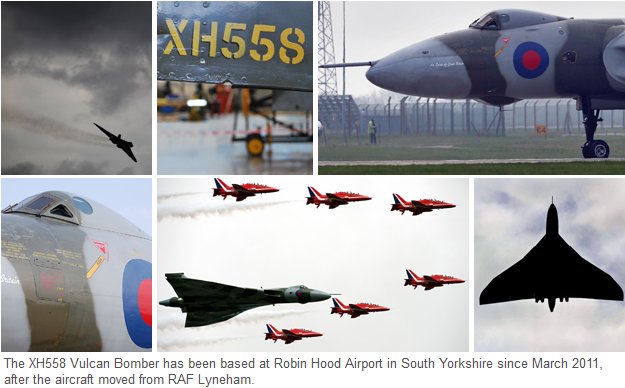
The Vulcan To The Sky Trust has announced “with considerable sadness” that this summer will be the public’s last chance to catch Avro Vulcan XH558 thundering through British skies, as the legendary V-bomber will be permanently grounded at the end of this flying season.
The trust explains that the axe will fall because “three expert companies on whom we depend – known as the ‘technical authorities’ – have together decided to cease their support at the end of this flying season”.
It elaborates:
At the heart of their decision are two factors. First, although we are all confident that XH558 is currently as safe as any aircraft flying today, her structure and systems are already more than ten percent beyond the flying hours of any other Vulcan, so knowing where to look for any possible failure is becoming more difficult. These can be thought of as the ‘unknown unknown’ issues, which can be impossible to predict with any accuracy. Second, maintaining her superb safety record requires expertise that is increasingly difficult to find.
Keeping XH558 in the air has been an epic undertaking, and not without wing-and-a-prayer moments involving last-minute injections of cash.
May 12, 2015
The Sky Was The Limit – World War 1 In The Air I THE GREAT WAR
Published on 11 May 2015
World War 1 saw several completely new technologies develop rapidly. The airplane itself was only a few years old but pioneering engineers soon saw its potential for military use. For recognisance and later as fighter or bomber, World War 1 had huge impact on aviation and warfare in general. This special episode gives you an idea about the obstacles that had to be overcome.
March 1, 2015
“The F-35 will cost more than the Manhattan Project every year for the next fifty years”
Scott Lincicome would like to point out to the contending Republicans hoping to become the GOP’s presidential candidate that defence spending is not immune to the massive overspending problem common to big government:
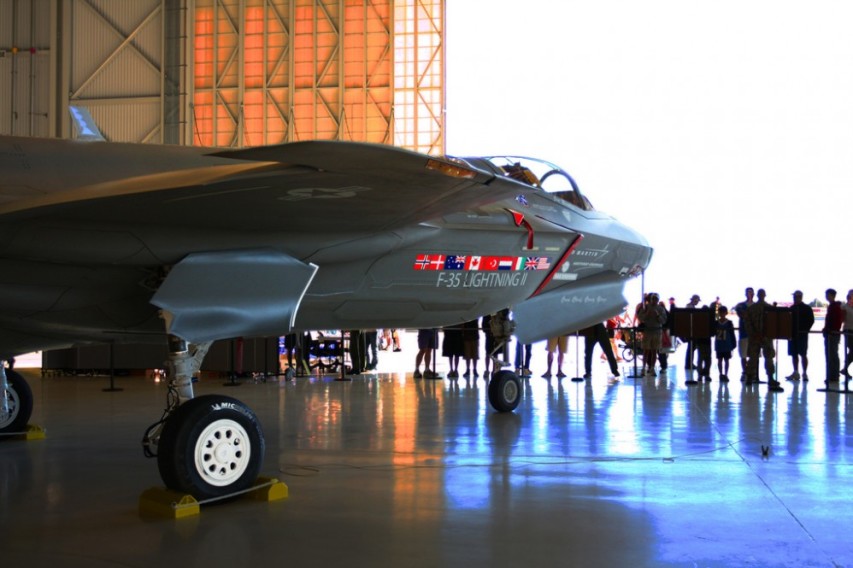
Over the next 20 months, a clown-car-full of Republican politicians will vie for their party’s presidential nomination. As the candidates crisscross the nation, each will undoubtedly call for smarter, leaner, and (hopefully) smaller government. However, there is one government program that, despite being a paragon of government incompetence and mind-bending fiscal incontinence, will most likely be ignored by these champions of budgetary temperance: the F-35 Joint Strike Fighter. In so doing, these Republicans will abandon their principles and continue a long, bipartisan tradition of perpetuating the broader problems with U.S. defense spending that the troubled jet symbolizes.
During the Obama years, the Republican Party magically rediscovered its commitment — at least rhetorically — to limited government and fiscal sanity. Criticizing the graft, incompetence, and cost of boondoggles like the 2009 stimulus bill, green-energy subsidies, or Obamacare, GOP politicians not only highlighted these programs’ specific failings, but also often explained how such problems were the inevitable result of an unwieldy federal government that lacked discipline and accountability and was inherently susceptible to capture by well-funded interest groups like unions or insurance companies.
They railed against massive bureaucracies, like the Department of Energy, that paid off cronies with scant congressional oversight. And, in the case of well-publicized debacles like the botched, billion-dollar Healthcare.gov roll-out, many Republicans were quick to note that the root of the problem lay not in one glitchy website, but the entire federal procurement process, and even Big Government itself
[…]
One wonders, however, if these Republicans’ philosophical understanding of Big Government’s inherent weaknesses extends to national defense and, in particular, the F-35. According to the latest (2012) estimate from the Pentagon, the total cost to develop, buy and operate the F-35 will be $1.45 trillion — yes, trillion, with a “t” — over the next 50 years, up from a measly $1 trillion estimated in 2011. For those of you keeping score at home, this means that the F-35’s lifetime cost grew about $450 billion in one year. (Who says inflation is dead?)
That number — $1.45 trillion — might be difficult to grasp, especially in the context of U.S. defense spending, so let me try to put it in perspective: the entire Manhattan Project, which took around three years and led to the development of the atom bomb, cost a total of $26 billion (2015), most of which went to “building factories and producing the fissile materials, with less than 10% for development and production of the weapons.” By contrast, the F-35 will cost $29 billion. Per year.
For the next 50 years.
February 16, 2015
Operation CRABSTICK
Think Defence looks back at an anti-invasion project to deny airfields to German forces along the southeast coast of England after the Dunkirk evacuation and onset of the Battle of Britain:
A method was also sought to deny the runway to enemy gliders and transport aircraft and so the Canadian Pipe Mine was devised by the 1st Canadian Tunnelling Company. 50-70mm steel pipes were inserted into the ground using hydraulic pipe pushing equipment and laid in a criss cross pattern about 6ft under the surface. They were subsequently filled with explosives, usually a blasting gelignite called ‘Polar Blasting Gelignite’ which was very powerful.
They were also called McNaughton Tubes after the GOC of 1 Canadian Division who according to his biographer got the idea for using hydraulic rams from bootleggers who used the method for creating an offsite distribution point for their whiskey!
Only 9 airfields were identified for mining initially but this rose to include other locations, by the end of 1942, after the threat of invasion had receded, 30 locations were mined, not all of them airfields. It is estimated that over 40,000ft of pipe mines were installed.
During the war some of the pipe mines were made safe and removed because of the deterioration of the explosive filler but most were left in situ. After the war Canadian engineers were tasked with removal but it seems from reading different sources that records were incomplete and some doubt exists whether the clearance activity was completed. Additional clearance efforts were made, one that resulted in the death of a Ukrainian worker at one of the locations.
February 13, 2015
Britain’s next defence review
Think Defence looks at the 2015 iteration of the British defence review process:
There is a pre defence review ritual that everyone with an interest indulges in. It starts with a few gentle discussions on Great Britain’s ‘place in the world’, the scale of our global ambition and obligations as a G8 regional power with a seat with our name on at the UN.
After a suitable period has elapsed the discussion then veers into areas of risk and threat but even during this phase the mood is still good natured.
Phase 3 gets heated because it is the first stage at which money is usually involved and therefore consideration of how the diminishing cake is sliced up between the services.
It is during this phase that negotiations and backroom deals kick in and the inevitable ‘test the water’ leaking to sympathetic journalists.
The final phase happens when it is all over and then as the implications of actual decisions made become clearer the bitterness sets in which can last for decades (see moving Australia and CVA01 for a good example).
If you start with the money and define a fixed budget you still get into the same argument and all that happens then is people tend to shape the first phases so that, oh look, my answer was right all along.
Start with risks and threats and the answers will always have to be tempered by the time it comes back around to budgets. Each review is rapidly made redundant by ‘events dear boy’ and the cycle starts again.
There are no easy answers and to think so is rather foolish, if there was an easy method, everyone would be doing it.
[…]
The ‘punching above our weight’ theme needs to be ruthlessly struck from the vocabulary because not only does it lead to illogical equipment decisions and hollowed out forces it fundamentally results in the talk loud small stick foreign policy that we seem unable to wean ourselves off.
You can only get away with this for so long until others start to realise you are bluffing and I believe this is where we are now, even our allies are starting to realise that our big talk isn’t backed up, despite having the worlds most advanced x or y, they are of little practical value if you only have a handful. Fur coat and no knickers could be an apt description of much of the UK’s defence capabilities, as painful as it may be for us all to recognise, and so I think there is a fundamental need to reassess ‘our place’.
February 9, 2015
The SR-71 “Blackbird”
At Sploid, Jesus Diaz shares some photos from the secret assembly line that built the SR-71 aircraft:
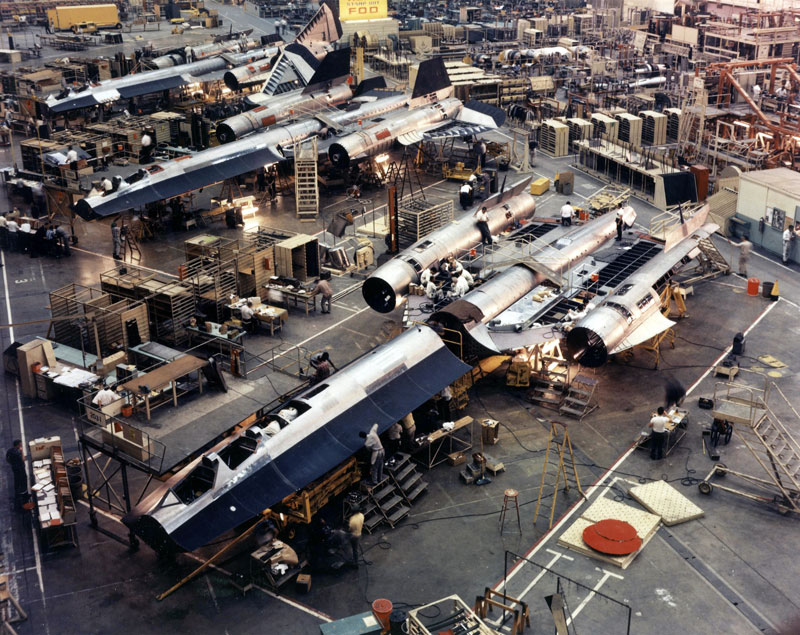
Built and designed in the 1960s after the A-12 Oxcart, the SR-71 Blackbird is still the fastest, most vanguardist air-breathing airplane in the history of aviation. These once classified photos reveal how Lockheed built both birds in secret, in California. They look taken at the Rebel base in Hoth.
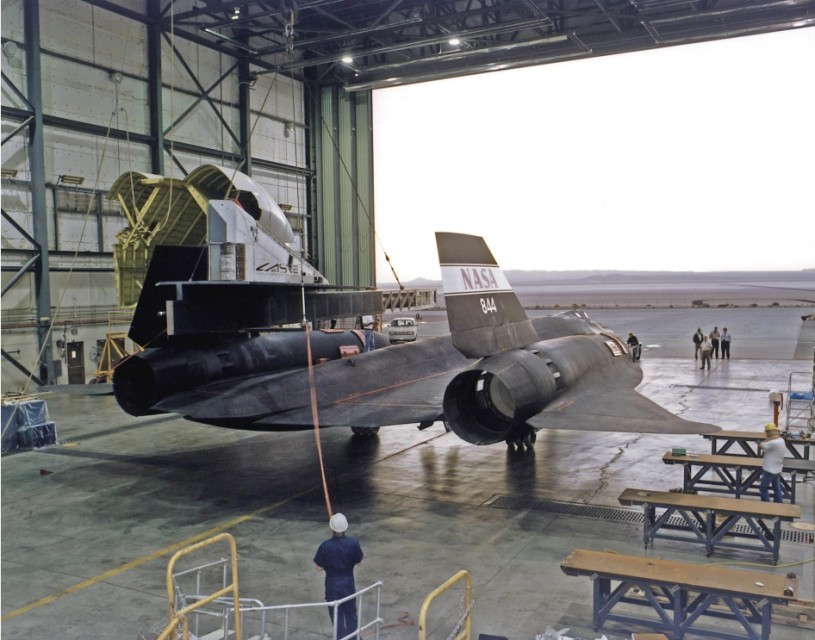
The Blackbirds kept flying long after their retirement from the USAF. One of them stayed at NASA: Here’s a photo from the Armstrong Flight Research Center (then Dryden) of an SR-71 being retrofitted for test of the Linear Aerospike SR Experiment (LASRE).
H/T to Dave Owens for the link, and also a H/T to Jeff for linking to another photo story about how the aircraft were transported from Lockheed’s Skunk Works to Area 51.
February 6, 2015
The Avro Arrow
Published on 2 Feb 2015
The Avro Canada CF-105 Arrow was a delta-winged interceptor aircraft, with nuclear rockets and missiles, designed and built by Avro Canada as the culmination of a design study that began in 1953. The Arrow is considered to have been an advanced technical and aerodynamic achievement for the Canadian aviation industry. The CF-105 (Mark 2) held the promise of near-Mach 2 speeds at altitudes of 50,000 feet (15,000 m) and was intended to serve as the Royal Canadian Air Force’s primary interceptor in the 1960s and beyond. But when it was canceled it was a ruin for Canada’s pride. – https://en.wikipedia.org/wiki/Avro_Canada_CF-105_Arrow
January 14, 2015
What Was The Bloodiest Battle Of World War 1? – OUT OF THE TRENCHES #6
Published on 12 Jan 2015
“Indy is answering your questions again. In this episode of OUT OF THE TRENCHES he is explaining how airplanes got armed with machine guns and what was the bloodiest battle of WW1.
December 8, 2014
The Luftwaffe attack at Bari in 1943
Patrick K. O’Donnell discusses one of the Luftwaffe‘s most deadly attacks and why most people have never heard of it:
Americans remember December 7 as Pearl Harbor Day, but most Americans have never even heard of the “Little Pearl Harbor,” which occurred in Bari Harbor, Italy, on December 2, 1943. More than 100 Luftwaffe bombers mounted a surprise attack on Allied ships moored in the harbor. Their bombs sank or rendered inoperable 28 of these ships. Nearly a thousand Allied troops were killed or wounded. along with hundreds of civilians.
Unbeknownst to those in the port, one of the ships carried liquid death in its belly. The American freighter John Harvey was secretly carrying mustard agent, in violation of international agreements that banned its use. President Franklin Roosevelt had covertly ordered the shipment of 100 tons of mustard agent to Italy for retaliation in the event that the Germans used chemical warfare against the Allied troops. The incident was covered up and remained a secret for decades.
When the German bombs hit the John Harvey, the ship’s hold immediately exploded with devastating violence, killing all those who knew about the mustard [gas]. Deadly liquid and gas flew high into the air and then slowly settled back down into the harbor, coating everything and everyone in the vicinity. Casualties would mount over the coming days and weeks as the agent slowly and painfully claimed the lives of many who had survived the initial attack.
Mustard gas was one of the nastiest relics of the attempts to break the trench lines during the First World War. Wikipedia says:
The sulfur mustards, or sulphur mustards, commonly known as mustard gas, are a class of related cytotoxic and vesicant chemical warfare agents with the ability to form large blisters on the exposed skin and in the lungs. Pure sulfur mustards are colorless, viscous liquids at room temperature. When used in impure form, such as warfare agents, they are usually yellow-brown in color and have an odor resembling mustard plants, garlic, or horseradish, hence the name. Mustard gas was originally assigned the name LOST, after the scientists Wilhelm Lommel and Wilhelm Steinkopf, who developed a method for the large-scale production of mustard gas for the Imperial German Army in 1916.
Mustard agents are regulated under the 1993 Chemical Weapons Convention (CWC). Three classes of chemicals are monitored under this Convention, with sulfur and nitrogen mustard grouped in Schedule 1, as substances with no use other than in chemical warfare. Mustard agents could be deployed on the battlefield by means of artillery shells, aerial bombs, rockets, or by spraying from warplanes.
November 11, 2014
In memoriam
A simple recognition of some of our family members who served in the First and Second World Wars:
The Great War
 Private William Penman, Scots Guards, died 1915 at Le Touret, age 25
Private William Penman, Scots Guards, died 1915 at Le Touret, age 25
(Elizabeth’s great uncle)- Private David Buller, Highland Light Infantry, died 1915 at Loos, age 35
(Elizabeth’s great grandfather) - Private Walter Porteous, Northumberland Fusiliers, died 1917 at Passchendaele, age 18
(my great uncle) - Corporal John Mulholland, Royal Tank Corps, died 1918 at Harbonnieres, age 24
(Elizabeth’s great uncle)
The Second World War
- Flying Officer Richard Porteous, RAF, survived the defeat in Malaya and lived through the war
(my great uncle) - Able Seaman John Penman, RN, served in the Defensively Equipped Merchant fleet on the Murmansk Run (and other convoy routes), lived through the war
(Elizabeth’s father) - Private Archie Black (commissioned after the war and retired as a Major), Gordon Highlanders, captured at Singapore (aged 15) and survived a Japanese POW camp
(Elizabeth’s uncle) - Elizabeth Buller, “Lumberjill” in the Women’s Land Army in Scotland through the war.
(Elizabeth’s mother) - Trooper Leslie Taplan Russon, 3rd Royal Tank Regiment, died at Tobruk, 19 December, 1942 (aged 23).
A recently discovered relative. Leslie was my father’s first cousin, once removed (and therefore my first cousin, twice removed).
In Flanders fields the poppies blow
Between the crosses row on row,
That mark our place; and in the sky
The larks, still bravely singing, fly
Scarce heard amid the guns below.We are the Dead. Short days ago
We lived, felt dawn, saw sunset glow,
Loved and were loved, and now we lie
In Flanders fields.Take up our quarrel with the foe:
To you from failing hands we throw
The torch; be yours to hold it high.
If ye break faith with us who die
We shall not sleep, though poppies grow
In Flanders fields.Lieutenant Colonel John McCrae, MD Canadian Army Medical Corps (1872-1918)
October 15, 2014
NORAD
From the RCAF website:
If you’ve watched action, drama or even science fiction movies and TV shows over the past 50 years, chances are pretty good that you’ve at least heard of NORAD, the North American Aerospace Defense Command.
Often, it’s depicted as a massive operations room with radar screens, uniformed personnel manning various stations and star-studded generals directing all the action. Every Christmas Eve, it’s the means by which millions of children get regular reports on Santa’s progress as he journeys around the world.
Outside of pop culture, however, NORAD is a real military entity. But what is it, and what do we really know about it? More importantly for Canadians, what impact does it have on Canada?
While NORAD is often depicted in film and television as an American entity, it is in fact a joint United States-Canada defence partnership charged with aerospace warning and control for both countries. What this means is that NORAD detects and advises both governments about airborne threats to North America (aerospace warning) and takes action to deter and defend against those threats (aerospace control).
“What it comes down to, essentially, is that Canada and the U.S. have airspace over our respective territories, and we should be in control of who enters it and how they conduct themselves in it,” explained Colonel Patrick Carpentier, the Canadian deputy commander of the Alaskan NORAD Region.
NORAD’s commander is directly and equally responsible to both the President of the United States and the Prime Minister of Canada. While it’s no secret that Canada and the U.S. enjoy a very close alliance, NORAD is truly unique in the world — no other two countries have an arrangement quite like it.
October 1, 2014
German Air Force pushed “to the very limits of its capacities”
German magazine Der Spiegel reports on the sad state of readiness in the German military:
Last week, a single person pushed Germany’s air force to the very limits of its capacities: Ursula von der Leyen, the country’s defense minister. Von der Leyen requested that two Transall military transport aircraft with missile defense systems be transferred to Amman, the Jordanian capital. The defense minister and a pool of reporters then flew for eight hours on Thursday morning in one of the aircraft to Erbil in Iraq’s Kurdish region. Back in Germany, the military had but a single additional Transall at its disposal.
After her arrival in Erbil, von der Leyen proceeded to the palace of the Kurdish regional government’s president. Her visit was to be concurrent with the delivery of German weapons, intended to aid the Kurds in their fight against Islamic State jihadists. Unfortunately, the machine guns and bazookas got stuck in Germany and the trainers in Bulgaria because of a dearth of available aircraft. One had been grounded because of a massive fuel leak. What could have been a shining moment for the minister instead turned into an embarrassing failure underscoring the miserable state of many of the Bundeswehr‘s most important weapons systems.
[…]
Against that backdrop and pressure from the international community, the ramshackle state of the Bundeswehr is no laughing matter in Berlin. At the moment, if Germany’s allies were to ask it to step up its participation in deployments in the Baltic states or Iraq, for example, Chancellor Merkel would likely have to politely pass, creating a highly embarrassing situation for the country. For the moment, though, most pressure related to the Bundeswehr‘s ailments has been directed at von der Leyen. Her critics argue that she has pursued a foreign and security policy vision that goes beyond the Bundeswehr‘s actual capabilities. Now she faces additional criticism that she tried to play down the military’s problems to members of parliament even though senior officials in her ministry were well aware of major shortcomings in the armed forces.
“Contrary to her own list of needed equipment, she created the impression in parliament that anything that could drive, fly or float was capable of full deployment,” said Rainer Arnold, the defense policy spokesman for the center-left Social Democrats (SPD). “But we members of parliament will not be taken for idiots.”
The defense minister hasn’t exactly been blind-sided by the criticism either — she’s known about the problems since before entering office almost a year ago. On Friday, she summoned the heads of the German army, navy and air force as well as the Inspector General of the Bundeswehr to her office for five hours of questioning, much of it centering on events in parliament last Wednesday.
H/T to Mark Collins for the link.
September 20, 2014
Russian air activity rises significantly
It may just be a co-incidence (or it may be that these intrusions happen all the time but are only occasionally reported), but I fired up my Twitter client this morning, these entries were almost consecutive in my Military list:
Russian bombers buzz northern U.K., intercepted by RAF Typhoons http://t.co/HUOchNehKV #military #defense #Putin pic.twitter.com/VpdAQMPhuI
— The Washington Times (@WashTimes) September 19, 2014
Breaking: US F-22's intercepted 6 Russian warplanes off Alaska yesterday, US officials believe tied to #Ukraine presidential visit
— Jim Sciutto (@jimsciutto) September 19, 2014
Canada CF-18s intercept 2 Russian bombers that entered its Air Defense Identification Zone http://t.co/5BvFdS6yA6 pic.twitter.com/BFQD8PSuEy
— NATOSource (@NATOSource) September 19, 2014
Russian ambassador has just received a protest against the grave violation of Swedish airspace by Russian fighters-bombers on Wednesday.
— Carl Bildt (@carlbildt) September 19, 2014
Update: CNN talks to a White House military representative about the US and Canadian intercepts.
Two Alaskan-based F-22 fighter jets intercepted two Russian IL-78 refueling tankers, two Russian Mig-31 fighter jets and two Russian Bear long-range bombers, a statement from NORAD said. The Russian planes flew in a loop and returned toward Russia.
Two Canadian CF-18 fighter jets intercepted two Russian Bear long-range bombers in the Beaufort Sea, the statement said.
Though the planes did not enter sovereign territory, the statement said, they did enter the U.S. Air Defense Identification Zone west of Alaska and the Canadian ADIZ, according to a statement.
The ADIZ is a zone of airspace which extends approximately 200 miles from the coastline and is mainly within international airspace, according to the statement. The outer limits of the ADIZ go beyond U.S. sovereign air space.
September 3, 2014
Britain’s shrinking armed forces
The Secretary of State for Defence was asked in Parliament for a breakdown of the members of the British army, Royal Navy and Royal Air Force. The detailed reply shows some significant changes:
Royal Navy/Royal Marines
| Year | Total, all ranks |
|---|---|
| 2010 | 38,730 |
| 2011 | 37,660 |
| 2012 | 35,540 |
| 2013 | 33,960 |
| 2014 | 33,330 |
| Year | Total, all ranks |
|---|---|
| 2010 | 108,920 |
| 2011 | 106,240 |
| 2012 | 104,250 |
| 2013 | 99,730 |
| 2014 | 91,070 |
| Year | Total, all ranks |
|---|---|
| 2010 | 44,050 |
| 2011 | 42,460 |
| 2012 | 40,000 |
| 2013 | 37,030 |
| 2014 | 35,230 |

